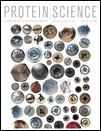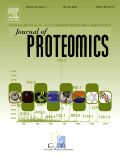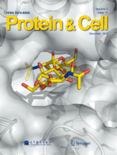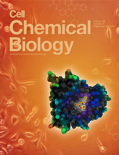
PROTEIN SCIENCE
Scope & Guideline
Driving Innovation in Molecular Biology and Medicine
Introduction
Aims and Scopes
- Protein Structure and Dynamics:
Research dedicated to elucidating the three-dimensional structures of proteins and their dynamics in various environments, often using techniques like X-ray crystallography, NMR spectroscopy, and cryo-electron microscopy. - Protein Engineering and Design:
Innovative methods in designing and engineering proteins for specific functions, including the development of novel enzymes, therapeutic proteins, and biosensors. - Protein-Protein Interactions:
Studies focusing on the interactions between proteins, including binding mechanisms, allosteric regulation, and the impact of post-translational modifications on these interactions. - Proteomics and Functional Studies:
Comprehensive explorations of protein expression profiles, modifications, and interactions within biological systems, often utilizing mass spectrometry and bioinformatics. - Disease Mechanisms and Therapeutic Targets:
Research elucidating the role of proteins in diseases, including neurodegenerative conditions and cancer, and the identification of potential therapeutic targets. - Computational Biology and Modeling:
Use of computational methods, including machine learning and molecular dynamics simulations, to predict protein structures, interactions, and dynamics. - Phase Separation and Biomolecular Condensates:
Investigating the role of protein phase separation in cellular processes and the formation of membraneless organelles.
Trending and Emerging
- Protein Phase Separation:
There is a significant increase in research exploring the phenomenon of liquid-liquid phase separation of proteins and its implications for cellular organization and function. - Machine Learning in Protein Science:
The integration of machine learning techniques for predicting protein structure, dynamics, and function is on the rise, showcasing the intersection of computational methods with experimental biology. - Post-Translational Modifications:
Investigation into the effects of post-translational modifications on protein function and stability is trending, reflecting an increased interest in how these modifications influence disease mechanisms. - Therapeutic Protein Engineering:
Emerging research is focusing on the design and engineering of therapeutic proteins, including novel biologics and biosensors, driven by the need for innovative treatment strategies. - Interdisciplinary Approaches:
There is a growing trend towards interdisciplinary research that combines structural biology, biochemistry, and computational techniques to address complex biological questions. - SARS-CoV-2 Research:
Research related to SARS-CoV-2, including protein interactions and therapeutic targeting, has surged, reflecting the global health crisis and the urgency of developing effective treatments.
Declining or Waning
- Traditional Biochemical Assays:
There appears to be a waning interest in traditional biochemical assays, as researchers increasingly turn to high-throughput and computational methods for studying protein interactions and functions. - Static Structural Studies:
The emphasis on static structural studies, while still relevant, has diminished compared to dynamic studies that explore protein flexibility and interactions in real-time. - Single-Domain Antibody Research:
Research focused on single-domain antibodies has seen a decrease, possibly due to the saturation of findings in this area and the growing interest in bispecific and multifunctional antibodies.
Similar Journals

Journal of Proteomics
Exploring the intricate world of proteins.Journal of Proteomics, published by Elsevier, is an esteemed peer-reviewed journal dedicated to advancing research in the field of proteomics, with broad implications for biochemistry and biophysics. Established in 2008, the journal has continuously evolved, embracing innovative methodologies and technologies that facilitate protein analysis from a variety of biological systems. With its current standing in the Q2 category for both biochemistry and biophysics as of 2023, it is recognized as a significant contributor to scientific literature. The journal publishes original research articles, reviews, and methodological advancements, providing invaluable insights for researchers, professionals, and students alike. Although it does not offer open access, the journal remains a crucial platform for disseminating knowledge that informs various applications, ranging from drug development to disease understanding. As it converges towards 2024, the Journal of Proteomics continues to solidify its role in shaping the future of proteomic research through rigorous scientific inquiry and innovation.

Protein & Cell
Exploring the Frontiers of Protein and Cell ResearchProtein & Cell, published by Oxford University Press, is a distinguished international journal focusing on cutting-edge research in the fields of biochemistry, biotechnology, cell biology, and drug discovery. This open access journal, active since 2014, is dedicated to disseminating innovative findings that advance our understanding of protein functions and cellular processes, making it an essential resource for researchers, professionals, and students alike. With an impressive 2023 impact factor reflected in its Q1 ranking across multiple categories such as Biochemistry, Drug Discovery, and Cell Biology, 'Protein & Cell' stands at the forefront of scientific research, driving collaboration and discussion in the scientific community. Researchers can access the journal freely online, fostering a global exchange of knowledge and contributing to significant advancements in medicine and biotechnology. Located in the United Kingdom, the journal strives to be a pivotal platform for impactful research that influences future studies and applications.

Cell Chemical Biology
Exploring the Intersection of Chemistry and Biology.Cell Chemical Biology, published by Cell Press, stands at the forefront of interdisciplinary research in the realms of biochemistry, molecular biology, and pharmacology. With a robust impact factor evident in its prestigious Q1 quartile rankings across multiple categories including Clinical Biochemistry and Drug Discovery for 2023, this journal serves as a critical platform for disseminating cutting-edge scientific discoveries. As an Open Access publication, it ensures that vital research is accessible to a wide audience, fostering collaborations and driving innovation in the life sciences. Based in the United States, and featuring publications from 2016 to 2024, Cell Chemical Biology invites researchers, professionals, and students alike to contribute to its mission of advancing knowledge through rigorous peer-reviewed articles that address both fundamental and applied aspects of chemical biology.

Journal of Structural Biology-X
Exploring the Foundations of Life at the Molecular LevelThe Journal of Structural Biology-X, published by Elsevier, is a leading open-access journal dedicated to advancing the field of structural biology. Launched in 2019, it has quickly established itself as a vital resource for researchers, professionals, and students, boasting a prestigious Q1 ranking in Structural Biology for 2023 and achieving an impressive Scopus rank of #19 out of 49 in the biochemistry, genetics, and molecular biology category. With an E-ISSN of 2590-1524, this journal emphasizes accessibility and collaboration by providing open access to its comprehensive collection of research articles, reviews, and cutting-edge methodologies. The scope of the journal encompasses significant themes within structural biology, including protein structure, molecular interactions, and imaging techniques, facilitating interdisciplinary dialogue and innovation. Join the global community of scientists and contribute to the body of knowledge that propels our understanding of molecular architecture through the Journal of Structural Biology-X.

BIOPHYSICAL CHEMISTRY
Innovating research at the crossroads of chemistry and biology.BIOPHYSICAL CHEMISTRY, published by Elsevier, is a prestigious journal with a long-standing tradition since its inception in 1973. This highly respected journal focuses on the intersections of biochemistry, biophysics, and organic chemistry, providing a critical platform for researchers, professionals, and students to disseminate pivotal findings in these dynamic fields. With an impressive impact factor that reflects its robust academic influence and high citation rates, it ranks within the Q2 quartile among its peers in multiple categories, indicating its significance in the scholarly community. The journal, hosted in the Netherlands, encompasses a diverse range of topics, from molecular interactions to protein folding, and serves as an essential resource for those engaged in cutting-edge research. Researchers looking to share their work with a global audience will find BIOPHYSICAL CHEMISTRY an invaluable outlet, fostering the advancement of knowledge in this crucial area of science. For more information, visit the journal's page on the Elsevier platform.

PROTEIN JOURNAL
Transforming Insights into Biomedical ApplicationsProtein Journal, published by Springer, stands as a significant academic resource in the fields of Analytical Chemistry, Biochemistry, Bioengineering, and Organic Chemistry. Since its inception in 1996, the journal has dedicated itself to the dissemination of high-quality research focused on protein chemistry and its biomedical applications. With an impressive impact reflected in its classification as a Q2 journal in Analytical Chemistry and Q3 in both Biochemistry and Bioengineering as of 2023, it provides an essential platform for researchers and practitioners to share their findings. The journal embraces the open-access model, enhancing accessibility to cutting-edge research. The Protein Journal is crucial for academicians, industry professionals, and students, catering to their need for rigorous scientific discourse and innovative discoveries in protein studies. With an established track record of converging over two decades of knowledge and research, it continues to influence and shape the advancements in this vital area of science.

TRENDS IN BIOCHEMICAL SCIENCES
Navigating the Evolving Landscape of BiochemistryTRENDS IN BIOCHEMICAL SCIENCES is a premier academic journal published by CELL PRESS, focusing on the latest advancements and insights in the dynamic fields of biochemistry and molecular biology. With an ISSN of 0968-0004 and an E-ISSN of 1362-4326, this journal has established itself as a leading source of high-impact research, boasting an impressive Q1 category ranking in both Biochemistry and Molecular Biology as of 2023. The journal's Scopus Ranks further highlight its significance, placing it in the top 3% and 4% of its respective fields, emphasizing its role as a vital platform for disseminating innovative research. Published since 1976 and continuing through 2024, TRENDS IN BIOCHEMICAL SCIENCES provides a comprehensive overview of the latest trends, methods, and applications, helping researchers, professionals, and students stay at the forefront of their disciplines. Although it offers traditional access options, the journal's rich content and authoritative analysis make it a must-read for those pursuing cutting-edge biochemical research.

PROTEINS-STRUCTURE FUNCTION AND BIOINFORMATICS
Transforming Data into Discoveries in Structural BiologyPROTEINS - STRUCTURE FUNCTION AND BIOINFORMATICS, published by WILEY, is a leading journal in the fields of biochemistry, molecular biology, and structural biology, recognized for its significant contribution to protein research since its inception in 1986. With its impressive rankings in the Q1 category for Biochemistry and Q2 for both Molecular Biology and Structural Biology in 2023, the journal serves as an essential resource for researchers and professionals seeking to explore the intricate relationships between protein structures and their functions. The journal, based in the United States, operates without an Open Access model, ensuring a curated selection of high-quality peer-reviewed articles that drive innovation and collaboration in the scientific community. Engaging with the robust content of PROTEINS not only bolsters academic scholarship but also opens avenues for groundbreaking discoveries that are pivotal in the advancing field of bioinformatics.

Molecular Cell
Where Innovative Research Meets Cellular Insight.Molecular Cell, published by Cell Press, is a leading journal in the fields of cell biology and molecular biology. Established in 1997, this prestigious journal boasts a significant impact within the scientific community, evidenced by its impressive 2023 Scopus rankings, placing it in the top 2% of its field (Rank #10/410 in Molecular Biology, Rank #12/285 in Cell Biology). With a focus on cutting-edge research that bridges the gap between molecular genetics and cellular function, Molecular Cell serves as an essential platform for the dissemination of vital findings and innovative methodologies. Although it follows a traditional publishing model without Open Access options, its rigorous peer-review process and high standards ensure that articles published within these pages are of the utmost quality, making it an invaluable resource for researchers, professionals, and students alike seeking to stay at the forefront of scientific discovery. The journal's address is 50 Hampshire St, Floor 5, Cambridge, MA 02139, United States, reinforcing its commitment to fostering scientific excellence and collaboration.

FEBS LETTERS
Igniting Passion for Molecular and Cellular ResearchFEBS LETTERS, published by Wiley, is a prestigious journal that has firmly established its place in the fields of biochemistry, biophysics, genetics, molecular biology, cell biology, and structural biology. With an esteemed history dating back to 1968, this journal continues to be a vital resource for researchers and professionals involved in the biological sciences. It boasts impressive quartile rankings, including Q1 statuses in several categories such as Biochemistry and Genetics, reflecting its high impact factor and significant contribution to scientific discourse. FEBS LETTERS provides a platform for innovative findings and critical reviews, fostering the exchange of knowledge and ideas within the scientific community. Although it operates under a subscription model, the journal ensures broad dissemination of groundbreaking research through its rigorous peer-review process. The vibrant discussions encouraged by articles published in FEBS LETTERS aim to inspire current and future generations of scientists to push the boundaries of biological understanding, making it an indispensable resource for anyone dedicated to advancing their knowledge in these dynamic fields.